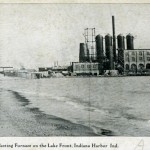Black and white photos of nattily dressed men and improbable-looking flying machines against a background of sand dunes instantly evoke the Wright Brothers’ pioneering flights at Kitty Hawk. But a closer look might show that the pictures weren’t shot in North Carolina–but Indiana–and date to the previous century.
Five years before Wilbur and Orville Wright began their aeronautical experiments, a Parisian-born civil engineer spent the summer of 1896 in the Indiana dunes conducting tests with gliders that ultimately served as the model for the first successful motorized airplanes.
Having served as the designer and chief engineer for many significant mid-century railroad projects, Octave Chanute began charting aeronautical innovation around the age of 60, his research resulting in the text, Progress in Flying Machines.
Chanute became convinced that achieving stability through adjustable surfaces and parts was essential before motorizing a flying machine.
Chanute brought a group of four colleagues to Miller Beach, on Lake Michigan in present-day Gary, in June 1896, to fly a series of gliders in the dunes.
Though Chanute himself never flew, the biplane glider he designed and tested there-which applied the principles of the truss bridge-became the industry prototype.
Attempting to keep a low profile, Chanute and his crew nonetheless attracted the attention of the media. The Westchester Tribune described the inventor as a “little man with gray hair and a “French style” beard. Locals told tales about “The Crazy Old Man of the Sand Dunes,” who, they insisted, thatched his gliders’ wings with chicken feathers.
Legend aside, the ten-year correspondence between Octave Chanute and Wilbur Wright is well documented, revealing a mutual respect. Chanute visited Kitty Hawk to witness the Wright Brothers’ experiments each summer from 1901 through 1903. “If he had not lived,” wrote Wright after his colleague’s death, “the history of human flight would have been quite different from what it has been.”
Now part of Marquette Park, the site of Chanute’s first flights is marked by a boulder bearing a bronze plaque memorializing the “father of aviation.”






















